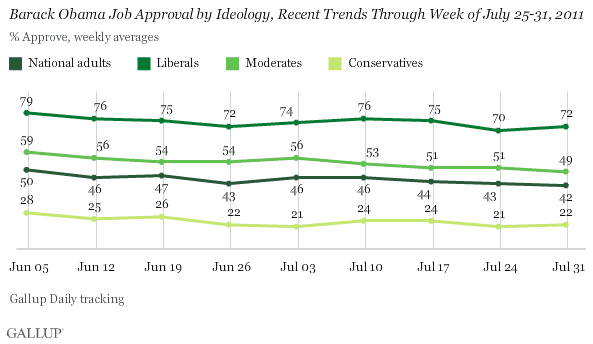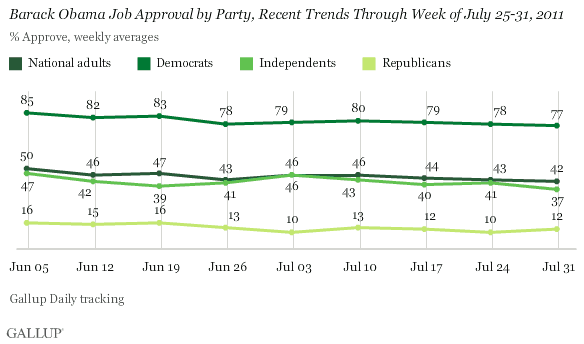PRINCETON, NJ -- President Obama's weekly job approval rating for July 25-31 is 42%, by one percentage point a new weekly low for his administration. Though his approval rating is down among all ideological groups in recent weeks, the broad pattern of the president's approval ratings across these groups remains similar to what it has been, with low support among conservatives, somewhat higher support among moderates, and high approval from liberals.

The last seven days were a tumultuous time in the nation's capital, with the president and both houses of Congress engaged in high-tension negotiations over budget legislation that would raise the debt ceiling by Aug. 2.
Most of the week's news headlines focused on failed plans and recriminatory accusations, although by Sunday, congressional leaders and the president announced the outline of a negotiated agreement. Twice last week, Obama's three-day rolling approval average reached 40%, the lowest such average of his administration. By the end of the weekend, his three-day average had rebounded slightly to 43%.
A number of reporters and columnists have speculated on how Obama's role in the agreement will affect his support within his liberal base. A New York Times online story over the weekend declared, "Outcry From the Left Precedes Debt Deal," while Times columnist Paul Krugman, in a Monday morning column headlined, "The President Surrenders," accused Obama of "folding" in the face of Republican threats. The website Politico carried a story on Monday morning headlined: "Debt deal complicates liberals' support."
Yet the data show that Obama's support from his liberal base remains as high relative to his overall average as it has throughout his term. Specifically, liberals' approval of Obama last week was 72%, 30 points higher than his overall approval rating of 42%. By comparison, liberals' approval has averaged about 28 points higher than his overall average so far in the Obama administration.
Democrats' Approval at 77%
Obama's job approval last week was 77% among Democrats, 37% among independents, and 12% among Republicans. This overall pattern of partisan difference is not substantially changed from the average such differences over the last 2 ½ years. Democrats have on average given Obama an approval rating 33 points higher than his overall rating, and last week their approval rating was 35 points higher. Obama's approval rating among independents has averaged four points lower than his overall rating, and last week their rating was five points lower. And Republicans have historically given Obama an approval rating 34 points lower than his national average; last week that gap was slightly narrower than usual, at 30 points.

Obama's support among Americans who identify themselves as both liberal and Democratic was 83% last week, little changed from previous weeks and slightly higher relative to Obama's overall approval rating than it has been historically.
Implications
Although President Obama's job approval rating hit the low point of his administration during the past week and is down among most subgroups, there are no signs yet that he has taken a disproportionate hit among his traditional base of liberals and Democrats. On a relative basis, both of these groups remain as loyal to Obama compared with Americans overall as they have been on average since he took office in January 2009.
Explore President Obama's approval ratings in depth and compare them with those of past presidents in the Gallup Presidential Job Approval Center.
Survey Methods
Results are based on telephone interviews conducted as part of Gallup Daily tracking July 25-31, 2011, with a random sample of 3,531, aged 18 and older, living in all 50 U.S. states and the District of Columbia.
For results based on the total sample of national adults, one can say with 95% confidence that the maximum margin of sampling error is ±2 percentage points.
Interviews are conducted with respondents on landline telephones and cellular phones, with interviews conducted in Spanish for respondents who are primarily Spanish-speaking. Each sample includes a minimum quota of 400 cell phone respondents and 600 landline respondents per 1,000 national adults, with additional minimum quotas among landline respondents for gender within region. Landline telephone numbers are chosen at random among listed telephone numbers. Cell phone numbers are selected using random-digit-dial methods. Landline respondents are chosen at random within each household on the basis of which member had the most recent birthday.
Samples are weighted by gender, age, race, Hispanic ethnicity, education, region, adults in the household, and phone status (cell phone only/landline only/both, cell phone mostly, and having an unlisted landline number). Demographic weighting targets are based on the March 2010 Current Population Survey figures for the aged 18 and older non-institutionalized population living in U.S. telephone households. All reported margins of sampling error include the computed design effects for weighting and sample design.
In addition to sampling error, question wording and practical difficulties in conducting surveys can introduce error or bias into the findings of public opinion polls.
For more details on Gallup's polling methodology, visit www.gallup.com.
